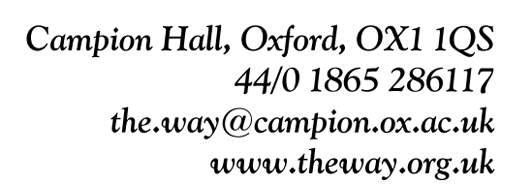


|  |
| January 2016 | Vol 55 No 1 |
To readers and friends of The Way, welcome to our new issue:
To order this new issue of The Way only, please click HERE.
Please click here to subscribe to The Way.
Contents
James Menkhaus
Lessons from the Spirit of Pedro Arrupe: For the Seventieth Anniversary of Hiroshima
Pedro Arrupe was Superior General of the Jesuits in the turbulent years immediately after the Second Vatican Council. Earlier on in his Jesuit life, he had been novice master in Hiroshima when the first atomic bomb was dropped on that city. Here James Menkhaus asks what lessons can be drawn from Arrupe’s experience seven decades after Hiroshima was destroyed.
Download this article in PDF format by clicking here
Anne Mouron
Praying with Images: Some Medieval Advice
Of the three Abrahamic faiths, Christianity has been most consistently content to use images as an aid to prayer. Here Anne Mouron describes a late medieval text, The Desert of Religion, which offered the monks for whom it was originally intended a series of meditative illustrations alongside its poetic text. This can suggest ways of incorporating such images into prayer in a way that has lost none of its relevance in the intervening centuries.
Robert E. Doud
Saints, the Church and Personal Prayer
‘The reason why the universal Church canonizes saints is so that we will look around us and see examples of holiness for us to copy’. Starting from this premise, and drawing on examples from poetry, art, and the writings of Thomas Merton, Robert Doud reflects on how such examples can touch our own prayer, and so enable a deeper growth of that holiness that is the ultimate goal of any Christian life.
Ambrose Mong
Bede Griffiths’s Advaitic Approach to Religion
Advaita is a Hindu term signifying a certain unity between human beings and the divine. The Christian theologian Bede Griffiths attempted to reconcile this notion with his own faith, and use it to open up a dialogue with Eastern religions. Although such an understanding remains controversial, Ambrose Ih-Ren Mong argues that it represents an important element in the relationship between Indian Christians and their Hindu neighbours.
Matt Kappadakunnel
Pray Anywhere
Matt Kappadakunel is a busy investment manager living in Los Angeles. Like many committed Christians, he struggles to find time to pray as he would wish to. Here, in our occasional Spirituality and Living strand, he offers a New Year reflection on ways of finding times and spaces for prayer.
Loan Le
A Reflection on the Charism of Religious Life
Within the Roman Catholic church, a ‘Year of Religious Life’ has just drawn to a close. Loan Le here draws on the thought of the French Dominican theologian Jean-Marie Tillard to show how a state of life characterized by the three vow of poverty, charity and obedience can only be fully understood in the context of the wider Church. For it is only within the Church that we can hear and respond to such a call of the Spirit.
Peter Wilcox
Paying Attention to the Wisdom of Our Sorrows
The idea of making use of the experience of sorrow in order to live a more positive and fruitful life may seem a strange one. However, in his work as a psychotherapist over the last three decades, Peter Wilcox has become convinced that this is possible. Here he suggests ways in which sorrows can indeed be used positively in this way, rather than being wasted in regret and recrimination.
Louis Roy
The Experience of the Absence Of God according to John of the Cross
The experience of God’s silence or seeming absence has been described by many Christians (and Jews) over many centuries. For some, this has led to an abandonment of their faith; for others, the experience has ultimately led them to a deeper trust in God. The Spanish Carmelite John of the Cross, reflected deeply on this phenomenon, and here Louis Roy traces some aspects of his thought.
Meredith Secomb
The “Ordinary” Contemplative Life and the “Little Way” of Social Justice
Many would think of the contemplative life as one that withdraws from the world and its demands into silence and prayer. As such it would seem to be the polar opposite of, and incompatible with, working for social justice. Meredith Secomb’s work in clinical psychologist has led her to believe that these two approaches to the world need to be brought together, and are not only compatible but mutually enriching.
To order this new issue of The Way, please click HERE.
You have received this e-mail because you have been in touch with us in the past. We will be sending out this kind of promotional e-mail at approximately quarterly intervals, but we are anxious not to send information to anyone who does not want to receive it. If you would prefer not to hear about new issues of The Way, or if you are receiving more than one copy of our message, please click here. Note that if you e-mail The Way again, you may need to unsubscribe again—our mailing list is maintained manually!